
It’s the year 2006, and the amazing astrophysicists at NASA have done it
again.
They have made the once science fiction movie a reality. No more day dreaming
about flying with Han in space. We have our own ship and it is a million times
better than the Millenium Falcon. The only problem is that not many people know

their way around space yet. How will we ever learn how to travel in space if
we
haven’t the faintest idea where the objects are in relation to each
other? Luckily,
the ingenious scientists had developed a system to relate the
objects in space to
each other. Let’s take the course on coordinate systems
so we can get flying in
outer space!
Some of you may be asking what exactly are coordinate systems? Believe me,
most of you probably know more that you think. We use coordinate systems all
the time on Earth. We can graph equations on the x-y coordinate system, we
can
read a map and determine how to get to our final destination, and we are
all familiar
with the latitude and longitude lines that we drawn on maps of
the Earth. But how
do we map the universe?
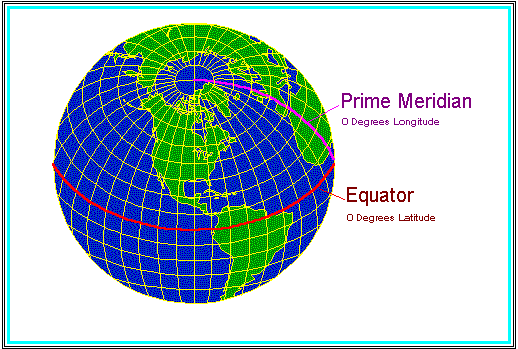
For more information on coordinate systems click on the picture below to access a website designed by
Peter H. Dana The Geographer's Craft Project, Department of Geography, The University of Colorado at Boulder.
That’s right, we use coordinate systems! Click on the map of the universe to learn more.
Now that you have learned a bit about Galactic coordinates. Answer the questions below.
Choose all of the possible answers.
The galactic plane is analogous to the
Prime Meridian
Equator
Tropic of Capricorn
Tropic of Cancer
How is the coordinate system used for the universe more complicated than the
coordinate system used for the Earth? (Hint: Think about the space the Earth
occupies).
Can you think of a disadvantage of plotting the universe on a map like the one above?
Okay, so now we know how we can map the objects in space on a map. But how
can
we determine how far the objects are from Earth? Easy, we just have to interpret
the map.
Look at the pictures below. Take note of the galactic coordinates.
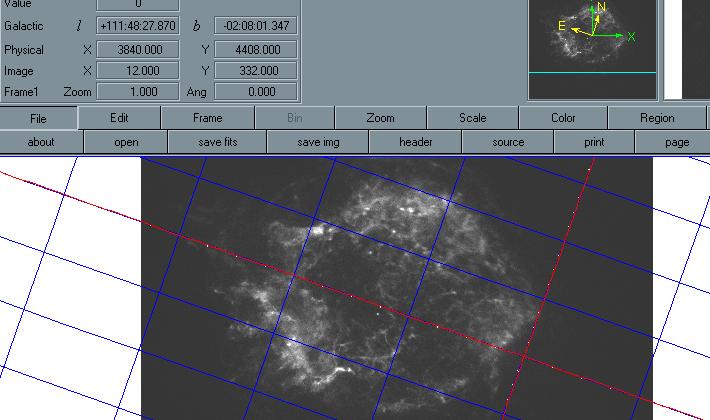
The picture above is of
Cassiopeia A.
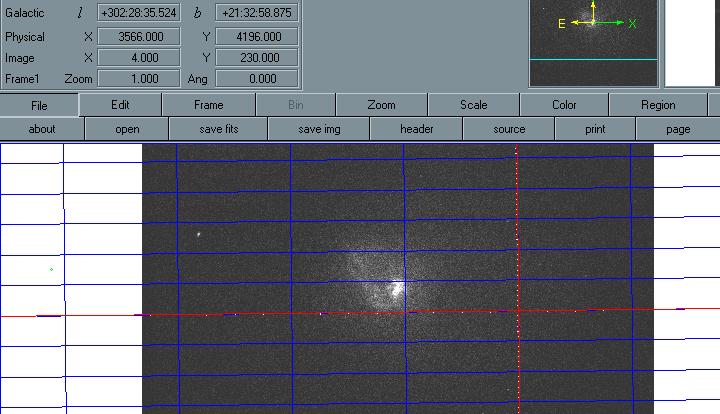
The picture above is of the
Large Magellanic Cloud Pulsar.
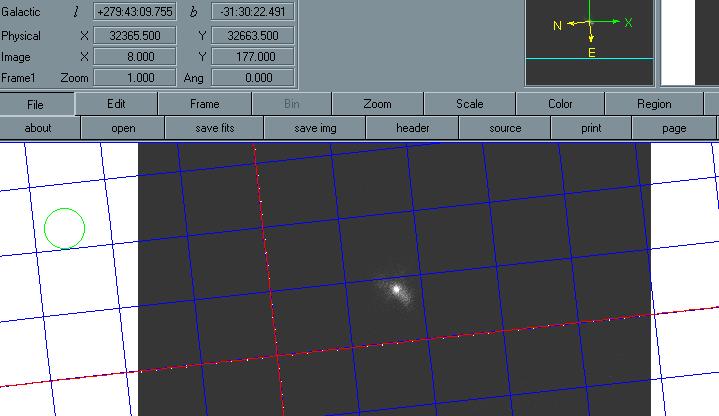
The picture above is of the Centaurus Cluster.
You may have noticed that the galactic coordinates are (l , b). These coordinates are written in the form 00:00:00.000 and have either a positive or a negative sign. However, only the b coordinate, the galactic latitude will be negative. Remember the galatic longitude plane starts at 0o and end at 360o. On the other hand, the l coordinate, on the galatic latitude plane, starts at -90o at the South Celestial Pole and goes to 90o at the Nort Celestial Pole. Remember the Earth is at 0o latitude.
As you can see on the picture above, l is the galactic longitude and b is the galactic latitude.
So now you are thinking, “Okay, I know about galactic coordinates, I
can determine
how far objects are in the sky, but what if I want to get somewhere
in space? How do
I find the galactic coordinates?” Don’t worry,
determining the galactic coordinates is as
easy as obtaining directions on
MapQuest. Unfortuantely, you will have to determine the
best route to get to
your destination. Hey, I never said being a pioneer was easy. But don’t
worry you shouldn’t run into too many meteors.
First, load the Chandra image that you are interested in and the analysis
software into Ds9.
Next go to the “WCS” option on the toolbar. Scroll down and choose “Galactic”.
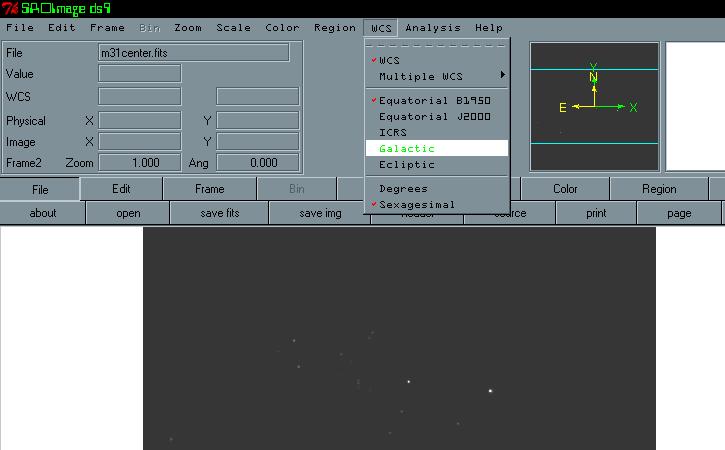
Next, go the “Analysis” option on the toolbar and choose “Display
Coordinate Grid”.
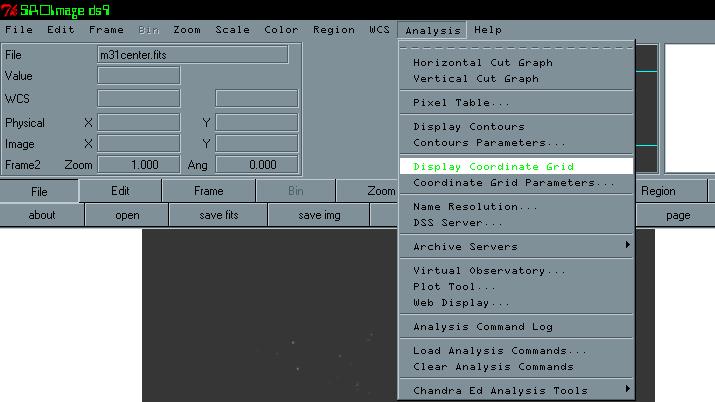
When you click on “Display Coordinate Grid,” gridlines should
appear that are similar to
the image below.
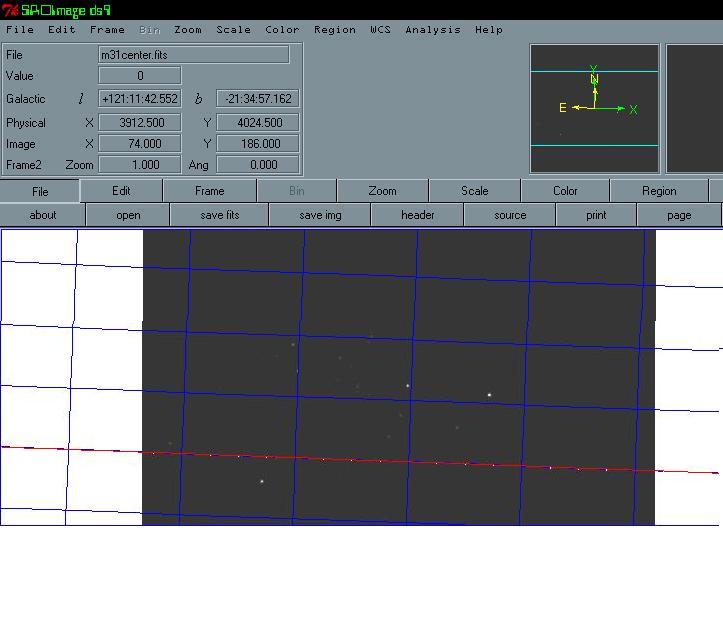
When you move the mouse to the red line the galactic coordinates (l, b) will
appear.
You have just found the galactic coordinates. Now it is time for the interpretation.
Helpful websites
http://cse.ssl.berkeley.edu/chips_epo/coordinates2.html
http://scienceworld.wolfram.com/astronomy/EquatorialCoordinates.html
Given equatorial coordinates (declination) and (right ascension), the galactic
coordinates
(b, l), can be computed from the formulas
The first system was defined in 1932 using optical observations of the Milky
Way Galaxy.
The new system was defined in 1958 in terms of 21 cm observations
of HI (Sullivan 1984, p. 140).
Declination
The celestial coordinate of an object corresponding to latitude projected on
the sky. Declination is
measured from -90° (projected south pole) to projected
north pole), with corresponding to the
celestial equator
declination Celestial coordinate system used to measure latitude above or below the celestial equator on the celestial sphere. [More Info: Field Guide]
Right Ascension
The azimuthal angle at which the hour circle of a celestial object is located.
The rotation axis taken
as the direction of the celestial pole. Right ascension
is usually measured in units of time (hours,
minutes, and seconds), with one
hour of time approximately equal to 15° of arc (360°/24 hours=15°/hour).
Because the time for the Earth to complete a rotation relative to the "fixed" stars
is slightly shorter than the
time to complete a rotation relative to the Sun
(a sidereal day is 23 h 56 m 4.1 s, whereas a solar day is 24
hours), one hour
of right ascension is actually equal to 360°/23.9344...hours= /h. The zero
point of right
ascension is the first point in Aries, just as the zero point
for longitude on the Earth is the prime meridian.
right ascension Celestial coordinate used to measure longitude on the celestial sphere. The zero point is the position of the Sun on the vernal equinox. [More Info: Field Guide]
http://star-www.st-and.ac.uk/~fv/webnotes/chapter8.htm